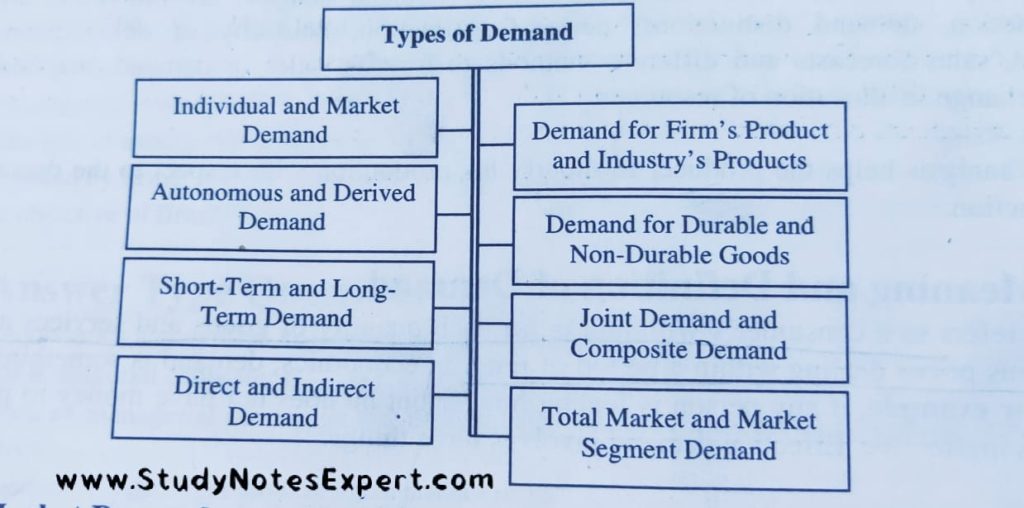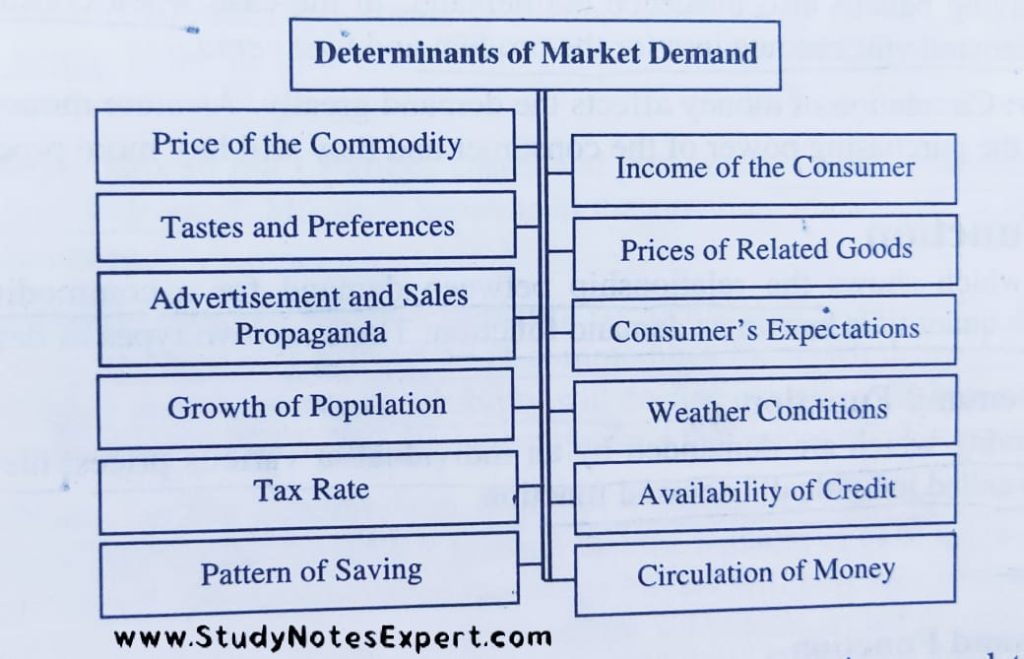In this article, we will discuss the different types of demand and you will learn the most effective factors that affect the market demand functioning. If you are looking for a descriptive answer, so follow this write-up till to the end.
Different 8 Types of Demand
These are the types of demand that we will mentioned in the below section:

1. Individual and Market Demand
It is one of the types of demand. Individual demand refers to such demand of an individual for the quantity of a commodity that he is eager to buy at a particular price during a specific time period, given his money income, his taste, and prices of other commodities (particularly, substitutes and complements). On the contrary, market demand is the sum of all individual demands for a commodity over a specific period of time, and at a given price, with other factors remaining the same.
2. Demand for Firm’s Products and Industry’s Products
The demand for the quantity which a firm produces at a given price over a time period is the demand for a firm’s product. Whether the cumulative demand for the product of all the firms in the industry is known as the market demand for the ‘industry’s product’.
3. Autonomous and Derived Demand
The demand for a commodity that is not related to the demand for other commodities is known as autonomous or direct demand. For example, the demand for goods such as food, shelter, clothes, vehicles, etc ., is autonomous because it arises due to biological, physical, and other personal needs of consumers. The demand for a commodity that is related to the demand of other commodities is known as derived demand. For example, the demand for petrol, diesel, and other lubricants is related to the demand of vehicles. This types of demand if highly impactable on the market demand.
4. Demand for Durable and Non-Durable Goods
Goods can be classified into two categories such as durable and non-durable goods. These are the types of demand. On the basis of these two categories, the demand can be classified into two categories such as demand for durable and non-durable goods. Durable goods are those which can be used for indefinitely long periods of time or continuously over a period. Durable goods may be consumer as well as producer goods. Durable consumer goods include clothes, shoes, owner’s-occupied residential houses, furniture, utensils, refrigerators, scooters, cars, etc. The durable producer goods include mainly the items under ‘fixed assets, such as buildings, plants, machinery, etc. On the other hand, non-durable goods are those which can be used only once. For example, food items.
5. Short-Term and Long-Term Demand
Short-term and long-term both are impactful types of Demand. Short-term demand refers to the demand for products that are used for a very short time period or for a current period. For example, demand for umbrellas, raincoats, sweaters, etc. is short-term in nature. Long-term demand refers to the demand for products over a longer period of time, For example, demand for durable goods, demand for producer goods, etc. is long-term in nature.
6. Joint Demand and Composite Demand
When demand for two or more two goods is mutually demanded at the same time to satisfy a single demand then it is called joint demand. It is one of the types of demand. Demand for bikes and petrol, coffee and sugar, pen and ink, etc., are examples of joint demand. When a commodity is demanded two or more distinct uses then it is said to be composite demand. For example, steel is demanded the purpose of making car bodies, making utensils, etc.
7. Direct and Indirect Demand
Direct demand refers to such demand which is directly used by the end consumer. The demand for such goods is also called consumer’s goods demand because these are used for final consumption. Demand for all consumers goods such as sweets, oil, readymade clothes, motorcycles, and houses is direct demand. Indirect demand is such demand for those goods which are not used by end consumers. These goods are used for producing other goods. Due to this, indirect demand is also referred to as producer’s goods demand.
8. Total Market and Market Segment Demand
The total market demand is referred to as the summative demand for the product from all the segments whereas market segment demand would refer to the demand the product in that specific market segment. For analysis of demand, both total markets, as well as market segment types of demand, is necessary. The market may be segmented on the basis of age, gender, geographical area, etc. For example, demand for Vadilal ice cream in India is the total market demand, and demand for Vadilal ice cream in Rajasthan or demand for Vadilal ice cream by women is a market segment demand.

12 Determinants and Factors Affecting Market Demand
These are the 12 factors affecting demand of a goods and we will discuss in the below segment:

1. Price of the commodity
According to the law of demand, there is an inverse relationship between price and quantity demanded of the community it is described that if the price is increased then the demand of the community decrease, and if the price decrease then the demand of the community increase it happens because of income and substitution effect. It is a high factor affecting market demand.
2. Income of the Consumer
Demand is also influenced by the income of the consumer. The purchasing power is affected by consumer income. If the consumer has more income he will buy more and if he has less income he will prefer less to buy. The high-income consumer has more purchasing power. It is one of the main factors affecting market demand. These are the 12 factor affecting demand of the market and especially in income of the consumer.
3. Tastes and Preferences
Consumer tastes and preferences are also considered important determinants of demand. If consumers have more preference for any commodity then automatically their demand will increase and vice versa.
4. Prices of Related Goods
Complimentary and substitute goods are generally known as related goods. The price of such goods is also considered an important determinant of demand. The demand for a product is also influenced by the prices of substitutes and complementary goods. It is one of the factors influencing market demand. When demand is fulfilled by alternative similar goods then these goods are called substitutes, such as Coca-Cola and Pepsi. When two commodities are complementing each other a fall in the price of one commodity (other things being equal) will cause a rise in demand for another commodity such as pen and ink. Therefore, the price of one good and the demand for another good are negatively associated. Price of related goods is one the major factors affecting market demand.
5. Advertisement and Sales Propaganda
In the present scenario, the tastes and preferences of consumers can be changed by advertisement and sales propaganda. Information about the product such as its availability of the product, the superiority of the product over the competitor’s products, is provided to the potential consumers with the help of advertisement to increase the demand for the product. The demand for FMCG products is largely triggered by advertisements.
6. Consumer’s Expectations
Consumer expectation is considered to be an important determinant of demand. If a consumer expects a hike in prices he may prefer to buy more quantity of that particular commodity and vice versa. Similarly, the expectation of rising income may force him to increase his current consumption. These types of factors highly affect the stable market demand.
7. Growth of Population
The growth of the population is an important determinant of demand. If the population increases the demand for the goods also increases naturally. Also, this factor is highly impactful in the market demand.
8. Weather Conditions
Climatic conditions affect the demand the most. The demand for certain items purely depends on climatic and weather conditions. Weather conditions is one of the factors of change in demand. For example, the demand for cold drinks, fans, and coolers during the summer season and the demand for umbrellas and raincoats during the rainy season.
9. Tax Rate
The demand is affected by the tax rate. If there is a high tax rate then there will be less demand for the goods. The tax is used as a weapon by the government for restricting the consumption of a particular commodity at a certain time. The demand for that commodity will be lower if the imposed tax is high.
10. Availability of Credit
One of the most considerable determinants of demand is credit availability. The purchasing power of the consumer is highly affected by the credit availability if there is the availability of cheap credit, the consumers try to buy more products.
11. Pattern of Saving
Saving patterns also influence demand. In the case when a consumer wants to save more money then his demand will become less for the product and vice versa. There are different kinds of saving and it impacts the market demand.
12. Circulation of Money
The circulation of money affects the demand greatly. As more money circulates among the people it increases the purchasing power of the consumer and they will buy more products.
Conclusion
In the above section, you know all the types of demand. Also, you will gain knowledge about the factors and determinants that affect the demand. These factors are prices of goods and services, income of the consumer, availability of substitutes, etc.
What are the Factors Affecting Demand?
The seven factors are:
1. Prices of goods and services 2. Incomes of consumers 3. Consumer tastes and preferences 4. Consumer expectations 5. The number of consumers in the market 6. The likes and preferences of other consumers, and 7. The availability of substitutes.
What are the 8 Types of Demand?
The eight types of demand are as follows:
1. Competitive Demand 2. Individual Demand 3. Joint Demand 4. Composite Demand 5. Derived Demand 6. Latent Demand 7. Effective Demand 8. Ineffective Demand
What are the Factors Affecting Market Demand?
Several factors can affect market demand for a product or service, including:
1. The price of the product or service 2. The availability of substitutes 3. Income levels 4. Population growth 5. Tastes and preferences 6. Consumer confidence.

